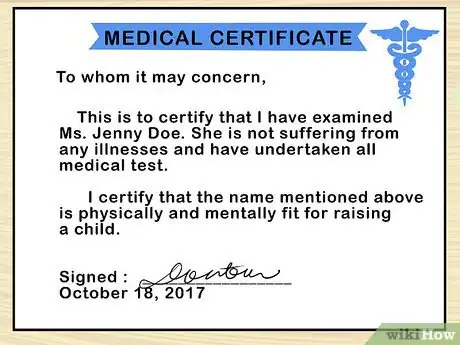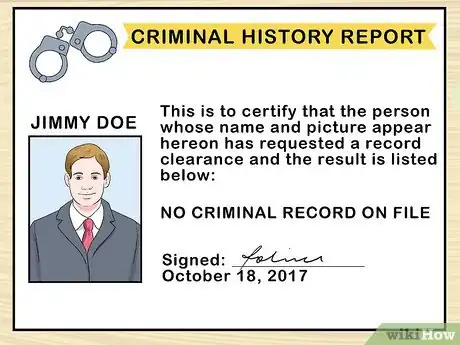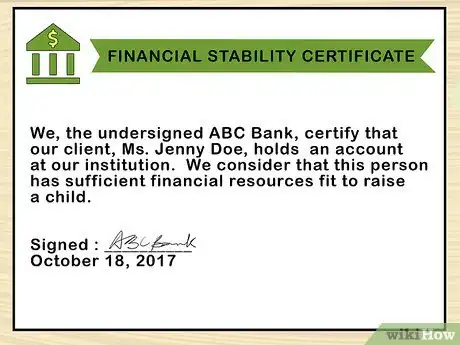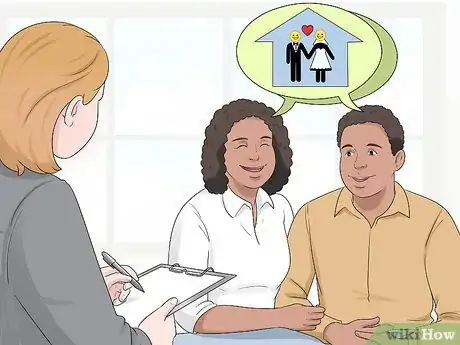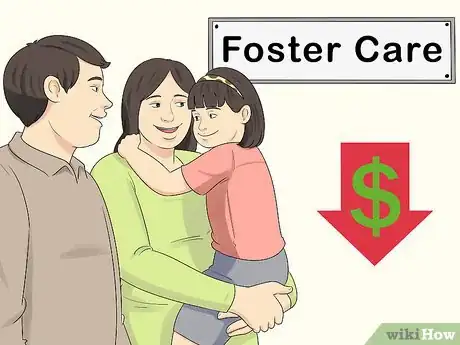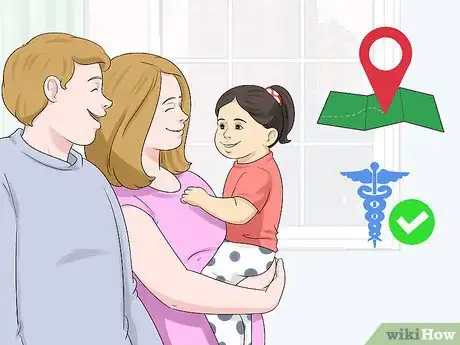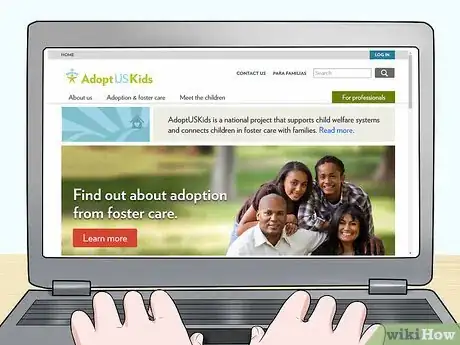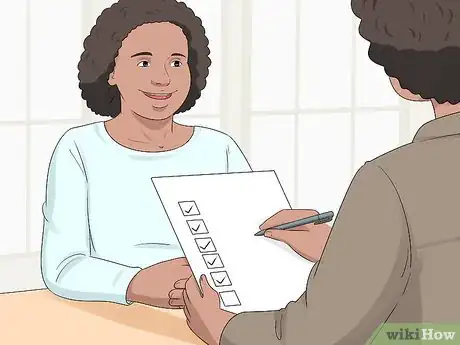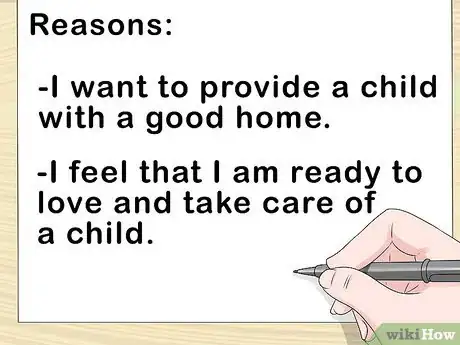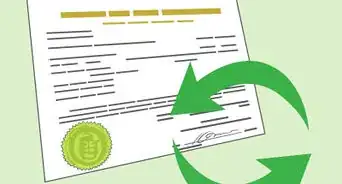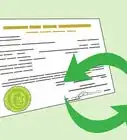This article was co-authored by wikiHow Staff. Our trained team of editors and researchers validate articles for accuracy and comprehensiveness. wikiHow's Content Management Team carefully monitors the work from our editorial staff to ensure that each article is backed by trusted research and meets our high quality standards.
There are 9 references cited in this article, which can be found at the bottom of the page.
wikiHow marks an article as reader-approved once it receives enough positive feedback. In this case, 84% of readers who voted found the article helpful, earning it our reader-approved status.
This article has been viewed 283,272 times.
Learn more...
Adopting a child can be a wonderful, life-changing experience. To begin the process, take some time to evaluate your life and make sure that you’re ready for this change. The adoption process, sometimes lengthy, will take patience, but the outcome will be a wonderful new addition to your family!
Steps
Meeting the Basic Requirements
-
1Provide evidence of good physical and mental health. Any adoption agency that you work with will want you to demonstrate that you are in good health. If you have a chronic health condition you will need a letter from your doctor stating that you are physically capable of caring for a child. Some states in the U.S. will also need a doctor’s word that you will likely live to see the child reach the age of 16.[1]
- If you have ever been on medication for a mental illness you will need a doctor’s letter stating that you are mentally stable. All members of the household must also be considered mentally stable by a medical professional.
- If you are pursuing an independent adoption, you might need to provide your attorney with this information. In the US, laws vary from state to state, but independent adoptions are typically bound by the same regulations as agency adoptions.[2]
-
2Share your criminal history. Typically, you will need local and federal clearance to adopt a child. This will vary from country to country. In the U.S., for example, you will be subject to a background check by both your state and the FBI. If you have an arrest on your record, you will need to write a letter explaining it. In some cases, the court might require some type of rehabilitation process.[3]
- Some criminal charges might keep you from ever adopting a child. For example, you would not be allowed to adopt with a history of child abuse.
Advertisement -
3Disclose your financial information. In order to adopt, you will probably need to be able to demonstrate that you are financially stable. This is an important indicator that you are capable of caring for a child. Depending on where you live, an agency will perform an assessment of your finances. There is generally not an income minimum that you have to meet, but you will need to show that you don’t have severe financial problems.[4]
- You will also need to provide proof of comprehensive health insurance coverage.
-
4Give information about your home environment. The agency will want to know some personal information about you. This isn’t meant to be invasive, it’s simply a way to help make sure the child would be going to a good home. You’ll need to provide details about your marital history, as well as background information about every member of your household.[5]
- In some cases, you might also be asked to provide letters of support from close friends or family. These letters will be a great way for you to showcase what a great parent you will be!
- For an independent adoption, your attorney should help you through this process.
Deciding to Which Adoption Path to Pursue
-
1Choose to adopt a child in care if you would like a less expensive process. There are many children who are in foster care and need a good home. To start the process, you'll need to find a local agency to work with. You might even want to begin by being a foster parent yourself, and if you connect with the child you could then decide to move forward with adoption. In the U.S., you can contact a local agency which will help you start the process. Other countries will likely have similar programs. You can also start by checking with your local government.[6]
- One of the benefits of adopting a child in care is that it costs very little or nothing. A negative is that it can be a very lengthy and frustrating process.
- Consider adopting an older child. Most people want to adopt infants, and there are more prospective parents than there are babies. The process might move more quickly if you’re open to an older child.
- This path is also known as public agency adoption.
-
2Look into licensed private agency adoption if you might want an open adoption. Another option is pursuing a private adoption. In this situation, birth parents release their legal rights to the child to a licensed agency. The agency then works to match the child with prospective parents. This path costs more than public adoption and be quite expensive.[7]
- One of the benefits of private adoption is that you may be able to choose to have an open adoption. This means that you will get an opportunity to meet and spend time with the birth parents. You can all decide together whether the birth parents will play a role in the child’s life.
- You should know that birth parents do not actually relinquish their legal rights until after birth. This means that they could change their minds about placing the child up for adoption.
-
3Pursue an independent adoption if you know a potential birth parent. You will need to work with an attorney to begin the process of an independent adoption. In most cases, you, the prospective parent, will have identified a birth parent that you would like to work with. Sometimes, an attorney might be helping a birth parent find an appropriate person to adopt their child. Each state and country have different laws for this process.[8]
- To get started, contact an attorney who has experience in this area.
-
4Research inter-country adoption if you are open to a child from a different background. No matter where you live, adopting a child from another country is typically a more complicated process than a domestic adoption. You will need to follow the laws from both your home country and the country where the child is from. In many cases, you will not receive much information on the child’s background or medical history. You’ll want to work with a pediatrician who has a lot of experience evaluating the health of kids coming from an unknown background.[9]
- Remember that when you adopt a child from another country, you’ll need to take into account possible differences in language and culture.
- You may or may not decide to visit the country where the child comes from before you take the child home.
-
5Pursue domestic adoption if you are concerned about the child's medical background. One of the benefits of domestic adoption is that you will be much more likely to be able to access information about the medical background of the child. Health care systems vary from country to country. It will be much easier to access information when you are already familiar with the system of your own country.[10]
- You might also want to pursue a domestic adoption if you strongly prefer an infant to an older child. The domestic process makes it more likely that an infant will be placed with you.
Going Through the Legal Process
-
1Select an adoption services provider. You will need help navigating the legalities of adoption. You can choose to work through a public or private adoption agency, and ask them to help you understand the laws. Another option is to immediately hire an experienced adoption attorney. Remember that the laws will differ depending on where you live and which path you are pursuing.[11]
- If you are working with an agency, it is a good idea to ask them to provide you with three references from people whom they have previously helped.
- It is also smart to do your own research. For example, in the U.S. you can contact Adopt US Kids to learn about different state laws, the reputation of agencies, and to learn about reputable attorneys.[12]
-
2Participate in a home study. This is another instance where the process will vary depending on which country or state you live in. Typically, no matter what type of adoption you are pursuing, a home study will be required. The home study phase will include you receiving educational materials about adoption, participating in interviews, and answering a lot of questions about your ability to care for a child.[13]
- In many cases, someone from the agency you are working with will make at least one visit to your home. They will want to take a look at the environment where you will be bringing the child you adopt.
-
3Go through the placement process. Once you have been approved to adopt a child, the placement process will begin. If you are working with a public agency you might be able to attend adoption events where you meet children waiting to be adopted. The agency might also send you pictures or videos of kids you might want to adopt. This will all depend on your preferences and the children who are available to adopt.[14]
- If you are pursuing a private adoption, your attorney will begin connecting you with potential birth parents.
- There’s no standard timeline that this process will follow. But it does typically take months, and oftentimes, years.
-
4File the required legal documents. In most countries, adoptions need to be finalized in court. In order to become the child’s legal parent you will need to file the appropriate documents with the court. Your agency or attorney will be able to help you with this process.[15]
Making Sure You are Ready to Adopt
-
1Write down your reasons for wanting to adopt a child. Before you begin the adoption process you’ll want to make sure that you are prepared emotionally and financially to begin the process. Spend some time thinking about why you want to adopt a child. It’s a good idea to write down your reasons and reflect on them.[16]
- You might write down that you want to provide a child with a good home.
- You might also note that you feel that you are ready to love and take care of a child.
- Don’t adopt a child if you are doing so to try to fix another relationship in your life. Another bad reason is that you are trying to fulfill some societal expectation.
-
2Make sure you have a support system. You’ve heard the saying that it takes a village to raise a child. You might not need an entire village, but you will absolutely need support. If you are in a relationship, make sure that you and your partner are on the same page. An adoption won’t work if you are not both committed. Talk openly and honestly about your thoughts on how to raise kids. Show your hopes and fears about how a child will change your life.[17]
- You should also talk to other family members. You want your child to be able to grow up in a loving and supportive family. Communicate your desire to adopt, and ask for their support.
-
3Ask yourself if you are ready for the responsibility. You’ll need to think long term before you begin the adoption process. If you adopt a baby, you’ll need to be thinking 18 years into the future. Consider things such as:[18]
- Whether you will raise your child in a certain religion.
- What type of child care provider you will use and how much you can afford to pay.
- How you want your child to be educated.
-
4Consider whether you are ready to go through the lengthy process. Adoption can be one of the most rewarding things you will ever do. However, it is important to be aware that the process can be lengthy and even frustrating. You might, for example, become attached to a foster child who is eventually reunited with their birth parents. Be prepared to deal with this sort of challenge.[19]
- Understand that many adoptions can also be financially costly.
Community Q&A
-
QuestionCan I adopt two children?
 Community AnswerAbsolutely, if you're up for the challenge and can provide care and support for both.
Community AnswerAbsolutely, if you're up for the challenge and can provide care and support for both. -
QuestionWhat do I need to do to adopt a grandchild whose mother has passed away?
 Community AnswerTalk to a lawyer or children's services if your grandchild has been taken into custody. This is usually a smooth transition, because children's services first looks for the nearest relative.
Community AnswerTalk to a lawyer or children's services if your grandchild has been taken into custody. This is usually a smooth transition, because children's services first looks for the nearest relative. -
QuestionCan I adopt a male child if I have only daughters?
 Community AnswerYes, you can. This is actually very common.
Community AnswerYes, you can. This is actually very common.
References
- ↑ https://adoptionnetwork.com/requirements-to-adopt-a-child
- ↑ https://www.babycenter.com/0_independent-adoption-risks-benefits-and-how-it-works_1373616.bc
- ↑ https://adoptionnetwork.com/requirements-to-adopt-a-child
- ↑ https://adoptionnetwork.com/requirements-to-adopt-a-child
- ↑ https://adoptionnetwork.com/requirements-to-adopt-a-child
- ↑ https://www1.nyc.gov/site/acs/child-welfare/become-foster-adoptive-parent.page
- ↑ https://www.childwelfare.gov/pubPDFs/f_adoptoption.pdf
- ↑ https://www.childwelfare.gov/pubPDFs/f_adoptoption.pdf
- ↑ https://www.childwelfare.gov/pubPDFs/f_adoptoption.pdf
- ↑ http://www.hope4kids.com/three-reasons-why-families-pursue-domestic-adoption/
- ↑ https://www.childwelfare.gov/pubPDFs/f_adoptoption.pdf
- ↑ https://www.adoptuskids.org/
- ↑ https://www.childwelfare.gov/pubPDFs/f_adoptoption.pdf
- ↑ https://www.childwelfare.gov/pubPDFs/f_adoptoption.pdf
- ↑ https://www.childwelfare.gov/pubPDFs/f_adoptoption.pdf
- ↑ http://www.webmd.com/parenting/features/ready-to-adopt#1
- ↑ http://www.hrc.org/resources/8-questions-to-ask-before-starting-the-adoption-process
- ↑ http://www.children.gov.on.ca/htdocs/English/adoption/thinking-of-adopting/index.aspx
- ↑ http://www.children.gov.on.ca/htdocs/English/adoption/thinking-of-adopting/index.aspx
About This Article
To adopt a child, you may first try working with local foster care agencies, since this option is significantly cheaper, and you have a chance to form a connection before adoption. If you want an open adoption, where the birth parents are involved, you can pursue licensed private adoption agencies. One last option you may try is adopting from another country. Make sure to do your own research and know the laws of the state and country you are adopting through, as well as the credibility of each agency. For more advice on preparing yourself for adoption, read on!
